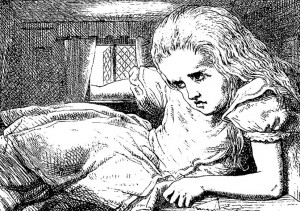In honor of Dr. Seuss’s birthday this week, we will draw our inspiration from a much-loved children’s book Alice in Wonderland.
Alice is chatting with the Mock Turtle and Gryphon when they ask her to tell them about her past. So much has happened to poor Alice in the past 24 hours that she says to her friends:
‘It’s no use going back to yesterday, because I was a different person then.’
What a liberating notion, that what is possible today could be completely unexpected and different from all the adventures that came before it. So often we become locked into patterns of relating to others based on our previous experiences. We’ve been hurt before so we protect ourselves through predictions and conclusions we draw based on yesterday’s stories. And we rarely take the time to check out whether our predictions are correct or if there might be another possible outcome.
 Here are 10 common thinking styles that can lead to symptoms of depression and anxiety and a feeling of being ‘stuck’ in our relationships and personal lives:
Here are 10 common thinking styles that can lead to symptoms of depression and anxiety and a feeling of being ‘stuck’ in our relationships and personal lives:
- All or Nothing Thinking: This is sometimes called black and white thinking and leads to the belief that something is only ever right or wrong.
- Negative Filter: Giving weight only to negative information or information that supports our negative assumptions
- Jumping to Conclusions: Believing that we know what others are thinking (Mindreading) or that we know what will happen (Fortune Telling)
- Emotional Reasoning: Assigning incorrect meaning to feelings “I’m embarrassed so I must be stupid”
- Labeling: Assigning labels to others and to ourselves
- Over-Generalizing: “People are always selfish”, “Nothing ever works out for me”
- Minimizing the Positive: Making excuses that diminish your accomplishments
- Catastrophizing: Blowing things out of proportion and imagining the worst possible outcome
- “Shoulding”: Using critical words like ‘should’, ‘must’, and ‘ought’ about ourselves can leave us feeling guilty and as if we’ve already failed. Using them about others can leave us frustrated when they fail to meet our expectations.
- Personalization: Taking responsibility for things that are not completely your fault or blaming others for something for which you bear some responsibility.
If you’d like your own “Through the Looking Glass” experience, consider choosing one of these patterns you recognize in yourself and spend an entire day challenging yourself to both notice when you are using the pattern and trying to do it’s opposite. For example, what might happen if, for each time you notice something negative in the day, you seek out something you can also appreciate?
Who knows what you might uncover? As Alice says:
“I knew who I was this morning, but I’ve changed a few times since then.”

